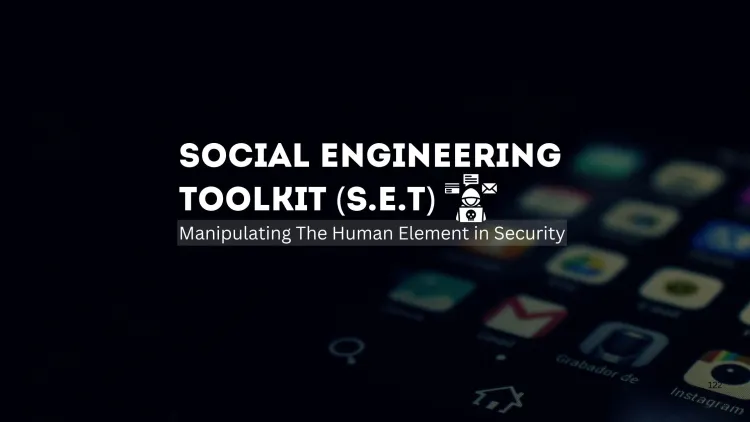Social Engineering Toolkit (SET): Manipulating the Human Element in Security | Overview, Features, and Why Ethical Hackers Use It
The Social Engineering Toolkit (SET) is an essential tool for ethical hackers looking to assess human vulnerabilities in cybersecurity. Its ability to simulate phishing, spear-phishing, and other social engineering attacks allows organizations to identify weaknesses in their security awareness programs. By leveraging SET, ethical hackers can help organizations bolster their defenses against human-centric threats and raise awareness about the importance of secure behavior.

The Social Engineering Toolkit (SET) is a powerful tool used by ethical hackers and penetration testers to simulate social engineering attacks and assess the effectiveness of an organization’s security measures against human manipulation. Social engineering is one of the most potent tactics used by cybercriminals, as it exploits human psychology to breach systems, steal sensitive information, and gain unauthorized access. This blog explores what the Social Engineering Toolkit (SET) is, its features, how it works, and why ethical hackers rely on it to strengthen cybersecurity defenses.
What is the Social Engineering Toolkit (SET)?
The Social Engineering Toolkit (SET), developed by TrustedSec, is an open-source penetration testing framework designed specifically for testing the human element of security. Unlike traditional security tools that focus on technical vulnerabilities in systems, SET aims to test the susceptibility of individuals within an organization to social engineering attacks—the manipulation of human behavior to exploit trust or deceive individuals into disclosing confidential information.
SET includes various attack vectors and pre-configured payloads that simulate common social engineering tactics, such as phishing, spear-phishing, and malicious websites. By conducting controlled social engineering campaigns, ethical hackers can identify vulnerabilities in human behavior and provide recommendations to mitigate these risks.
Why Ethical Hackers Use SET
Ethical hackers leverage the Social Engineering Toolkit to evaluate and enhance the effectiveness of an organization’s security awareness program. Here are the main reasons why ethical hackers choose SET:
1. Testing Human Vulnerabilities
Social engineering attacks exploit human psychology, making employees the most significant vulnerability in an organization's security system. SET allows ethical hackers to simulate various types of social engineering attacks to assess the awareness and response of individuals when faced with phishing attempts, malicious emails, and other manipulative tactics.
2. Comprehensive Attack Vectors
SET provides a wide range of social engineering attack methods, enabling ethical hackers to test various scenarios. These include:
- Phishing Attacks: Sending deceptive emails or messages to trick individuals into clicking malicious links or downloading harmful files.
- Spear-Phishing: A more targeted form of phishing aimed at specific individuals or organizations, often using personal information to appear more legitimate.
- Credential Harvesting: Collecting sensitive login details from victims through fake login pages.
- USB Infection: Malicious code can be planted onto USB drives, which, when inserted into an organization’s computer, can compromise the system.
- Web Shells and Reverse Shells: Utilizing web-based attacks to gain control of systems.
These features allow ethical hackers to conduct diverse and comprehensive tests to identify the most vulnerable points in an organization’s defenses.
3. Easy-to-Use Interface
SET is designed with user-friendliness in mind. It provides an interactive command-line interface (CLI) and menu-driven setup that simplifies the process of configuring and running attacks. Ethical hackers do not need extensive technical expertise to use SET effectively, making it accessible even to beginners in the field of penetration testing and security.
4. Training and Awareness
By using SET, ethical hackers can simulate realistic social engineering attacks to train employees and raise awareness about the importance of security hygiene. The tool helps organizations understand the risks posed by social engineering attacks and prepare employees with the knowledge to detect and respond to such threats.
5. Red Team Simulations
SET is often used in red teaming exercises, where ethical hackers simulate an actual attacker’s tactics, techniques, and procedures (TTPs). These exercises help organizations identify weaknesses in their security policies and procedures, especially when dealing with human error or manipulation.
Key Features of the Social Engineering Toolkit
1. Phishing Attack Campaigns
SET is known for its phishing capabilities, allowing users to create fake websites that resemble legitimate ones. This can be used to capture sensitive data, such as usernames and passwords, when victims unknowingly input their credentials on the fake sites.
- Credential Harvesting: Set up fake login pages for email accounts, bank accounts, or internal company resources to capture login credentials.
- Email Phishing: SET can send mass phishing emails to employees, testing their response to suspicious links or attachments.
2. Payload Delivery
The toolkit can deliver a range of malicious payloads through phishing emails, USB drives, and malicious links. These payloads are designed to compromise systems once executed. SET supports reverse shells, which allow attackers to gain remote access to a system after the victim interacts with a malicious link.
3. Mass Emailer
SET’s mass email feature allows ethical hackers to send personalized phishing emails to multiple recipients at once. The tool includes pre-built templates for common phishing attacks, which can be customized with specific target information.
4. Website Cloning
SET includes a powerful website cloning feature that enables users to create an exact replica of a legitimate website. This replica can be used to deceive targets into entering their credentials or downloading malware.
5. USB Drop Attack
One of the most interesting features of SET is its ability to create malicious USB drives. By configuring a USB device to automatically run malicious payloads, ethical hackers can test how easily physical access to a device can lead to a compromise.
6. Social Engineering Attack Vector Configuration
SET provides multiple pre-configured attack vectors that allow users to simulate various types of social engineering attacks with minimal setup. This includes common techniques like phishing, spear-phishing, and Bait-and-Switch attacks.
7. Interactive Interface
SET provides an intuitive interface that makes configuring and running attacks easy. The menu-driven interface allows users to select the type of attack, customize it, and execute it with just a few commands.
How SET Works
1. Initial Setup
To begin using SET, ethical hackers must first install the toolkit, which is available for Linux-based systems. Once installed, the toolkit can be launched through the command line interface. SET also supports integration with the Metasploit framework for payload delivery.
2. Selecting an Attack Vector
Ethical hackers can choose from a variety of attack vectors, such as phishing, spear-phishing, credential harvesting, or website cloning. Each attack type can be configured with different parameters to simulate a realistic attack scenario.
3. Configuring Payloads
SET allows the user to configure payloads that will be delivered as part of the attack. These payloads can be anything from a simple reverse shell to a more sophisticated malware delivery mechanism.
4. Launching the Attack
After configuring the attack, the user can launch the campaign. SET will execute the attack and monitor the results, such as whether the victim clicked on a phishing link or provided their credentials on a fake website.
5. Reviewing Results
Once the attack has been executed, SET provides detailed reports that show the effectiveness of the attack. Ethical hackers can analyze these results to understand the vulnerabilities in human security awareness and make recommendations for improving defense mechanisms.
Benefits of Using SET for Ethical Hackers
1. Testing Human Vulnerabilities
SET is specifically designed to test human vulnerabilities, which are often the weakest link in an organization’s security chain. By simulating real-world attacks, ethical hackers can identify weaknesses in an organization’s defense and raise awareness.
2. Comprehensive Social Engineering Attacks
With a wide range of pre-configured attacks, SET makes it easy for ethical hackers to simulate various types of social engineering tactics and techniques.
3. Easy to Use and Customizable
SET’s interactive interface and customizable attack vectors make it an accessible tool for both beginners and experienced penetration testers. It allows for both simplicity and depth in its configurations.
4. Raises Awareness
By running controlled social engineering attacks, SET helps organizations increase awareness of human-centric risks and prepare their employees to handle real attacks more effectively.
5. Enhances Security Posture
Running social engineering tests through SET can identify the weaknesses in security training programs and help improve overall cybersecurity policies.
Best Practices for Using SET
- Always Obtain Permission: Before running any social engineering tests, ensure that you have explicit permission from the target organization.
- Simulate Real-World Scenarios: Customize your attacks to mimic real-world tactics and techniques to make them as realistic as possible.
- Analyze Results Thoroughly: Use the data collected from SET campaigns to provide actionable feedback and recommendations for improving human security awareness.
- Regular Training: Regularly use SET to conduct social engineering tests and train employees to recognize and respond to attacks.
Conclusion
The Social Engineering Toolkit (SET) is an indispensable tool for ethical hackers who aim to test and improve human security defenses. By simulating realistic social engineering attacks, SET helps identify vulnerabilities in human behavior, which are often the most overlooked aspect of cybersecurity. With its user-friendly interface, comprehensive attack vectors, and the ability to raise awareness, SET is a critical asset for strengthening the security posture of any organization.
10 FAQs About SET
-
What is the Social Engineering Toolkit (SET)? SET is a penetration testing framework designed to simulate social engineering attacks like phishing and spear-phishing to test the effectiveness of human security defenses.
-
Is SET an open-source tool? Yes, the Social Engineering Toolkit is open-source and available for free under the GPL license.
-
What types of attacks can SET simulate? SET can simulate various social engineering attacks, including phishing, spear-phishing, credential harvesting, USB infections, and website cloning.
-
Can SET be used for training employees? Yes, SET is often used to train employees to recognize and respond to social engineering attacks and improve security awareness.
-
How does SET perform phishing attacks? SET allows users to create fake websites or email campaigns designed to trick victims into revealing sensitive information.
-
Is SET easy to use? Yes, SET has an interactive command-line interface that is simple to navigate, making it accessible for both beginners and experienced penetration testers.
-
Can SET deliver reverse shells? Yes, SET can deliver payloads that allow attackers to create reverse shells, giving them remote access to compromised systems.
-
What platforms is SET compatible with? SET is primarily designed for Linux-based systems but can be installed on other operating systems with the right dependencies.
-
Can SET be used for penetration testing? Yes, SET is commonly used by ethical hackers for penetration testing, focusing on testing the human element of security.
-
Should SET be used without permission? No, ethical hackers should always obtain explicit permission before using SET to test systems or individuals to ensure compliance with legal and ethical standards.














![Top 10 Ethical Hackers in the World [2025]](https://www.webasha.com/blog/uploads/images/202408/image_100x75_66c2f983c207b.webp)








